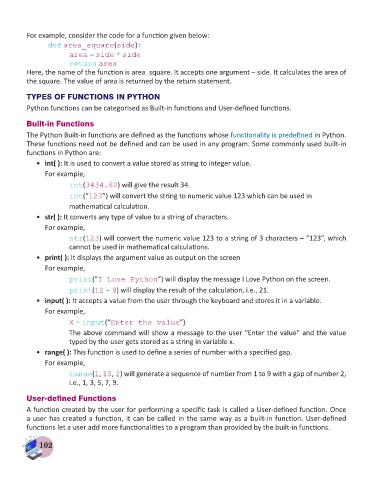Page 104 - Computer - 8
P. 104
For example, consider the code for a function given below:
def area_square(side):
area = side * side
return area
Here, the name of the function is area_square. It accepts one argument – side. It calculates the area of
the square. The value of area is returned by the return statement.
TYPES OF FUNCTIONS IN PYTHON
Python functions can be categorised as Built-in functions and User-defined functions.
Built-in Functions
The Python Built-in functions are defined as the functions whose functionality is predefined in Python.
These functions need not be defined and can be used in any program. Some commonly used built-in
functions in Python are:
• int( ): It is used to convert a value stored as string to integer value.
For example,
int(3434.60) will give the result 34.
int(“123”) will convert the string to numeric value 123 which can be used in
mathematical calculation.
• str( ): It converts any type of value to a string of characters.
For example,
str(123) will convert the numeric value 123 to a string of 3 characters – “123”, which
cannot be used in mathematical calculations.
• print( ): It displays the argument value as output on the screen
For example,
print(“I Love Python”) will display the message I Love Python on the screen.
print(12 + 9) will display the result of the calculation, i.e., 21.
• input( ): It accepts a value from the user through the keyboard and stores it in a variable.
For example,
X = input(“Enter the value”)
The above command will show a message to the user “Enter the value” and the value
typed by the user gets stored as a string in variable x.
• range( ): This function is used to define a series of number with a specified gap.
For example,
range(1, 10, 2) will generate a sequence of number from 1 to 9 with a gap of number 2,
i.e., 1, 3, 5, 7, 9.
User-defined Functions
A function created by the user for performing a specific task is called a User-defined function. Once
a user has created a function, it can be called in the same way as a built-in function. User-defined
functions let a user add more functionalities to a program than provided by the built-in functions.
102

